
The Impact of US-Mexico Tariffs on North America

US tariffs on Mexican imports could reshape the economic landscape of North America, affecting trade between the US and Mexico, as well as Canada. While intended to protect domestic industries, tariffs often create ripple effects across supply chains and trade relationships. The consequences vary in the short and long term, influencing economic stability, investment flows, and market competitiveness.
Short-Term Effects of US-Mexico Tariffs
When US tariffs on Mexico are imposed, immediate economic disruptions follow. The Mexican peso (MXN) often depreciates as investors react to uncertainty. This currency adjustment helps offset some negative effects on GDP by making Mexican exports more competitive. However, the overall impact depends on the magnitude of tariffs and the industries affected.
Key Short-Term Effects:
- MXN depreciation – Currency weakens, making exports cheaper but increasing inflation risks.
- Supply chain disruptions – Higher costs for US manufacturers reliant on Mexican components.
- Decline in US-Mexico trade – Reduced exports and imports affect GDP in both countries.
- Price increases in US markets – Higher consumer prices for goods with Mexican components.
US Employment in the Manufacturing Industry
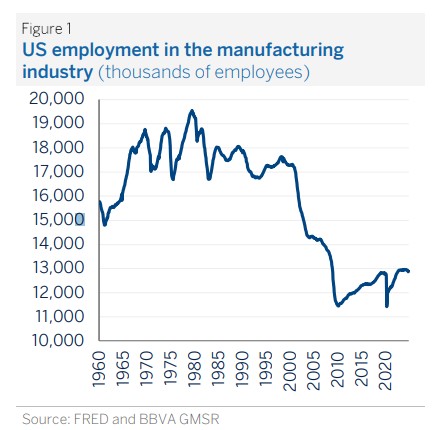
Figure 1: US Employment in Manufacturing – This graph highlights the decline in US manufacturing employment since 1960, showing the challenges faced by domestic industries. US tariffs on Mexico aim to boost local manufacturing jobs, but long-term trends suggest automation and global competition play a larger role.
Change in manufacturing employment USA
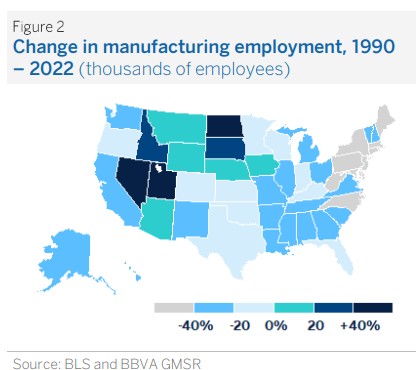
Figure 2: Change in Manufacturing Employment (1990-2022) – A state-by-state analysis of US manufacturing employment shifts. While some states gained manufacturing jobs, many lost them. Tariffs may impact these regional shifts by influencing production costs and supply chains.
Long-Term Consequences of Tariffs on US-Mexico Trade
Over time, US-Mexico tariffs influence corporate strategies, global supply chains, and economic policies. In North America, businesses have spent decades optimizing trade routes under free trade agreements like NAFTA and its successor, the United States-Mexico-Canada Agreement (USMCA). Increased tariffs disrupt these established systems, forcing companies to rethink sourcing, production, and distribution.
Key Long-Term Effects:
- Shift in manufacturing – Companies may move production from Mexico to Asia or the US.
- Job losses in Mexico – Industries reliant on US trade could shrink.
- Higher production costs – Tariffs raise costs for automotive, electronics, and agricultural sectors.
- Inflation risks – More expensive imports could drive up US inflation.
Trade Openness USMCA
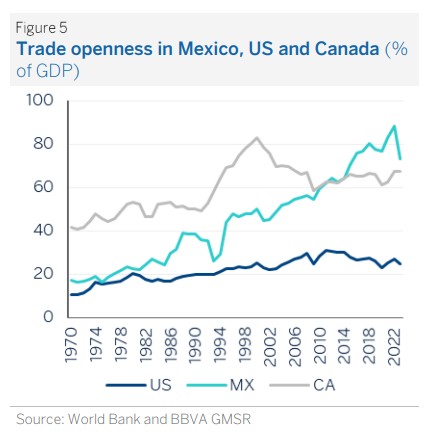
Figure 3: Trade Openness in Mexico, US, and Canada – This chart illustrates how trade as a percentage of GDP has evolved in the three countries. Mexico is highly dependent on trade, making it more vulnerable to tariffs compared to the US and Canada.
USMCA Trade Share
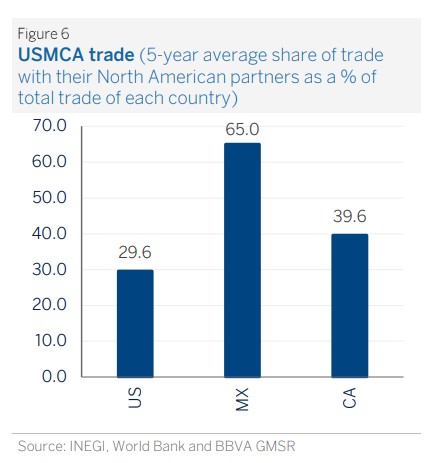
Figure 4: USMCA Trade Share – This bar chart shows the importance of USMCA trade among the three nations, with Mexico relying most heavily on trade within North America. Tariffs could disrupt these relationships, particularly for industries with tightly integrated supply chains.
If tariffs on Mexican goods remain high for an extended period, industries may shift manufacturing operations. The automotive sector provides a clear example. Cars and components cross the US-Mexico border multiple times before final assembly. Higher tariffs increase production costs, making vehicles more expensive and reducing consumer demand. This could weaken industry competitiveness, leading to job losses and investment declines.
US-Mexico Tariffs as a Political Strategy
Donald Trump’s administration has historically used tariffs as a political tool. His policies in previous terms included imposing duties on Chinese goods and renegotiating NAFTA into the USMCA. Now, he has proposed new tariffs, including a 25% tariff on imports from Mexico and a 200% tariff on cars manufactured in Mexico.
Main Political Motivations for Tariffs:
- Leverage in trade negotiations – Tariffs pressure Mexico to renegotiate trade agreements.
- Domestic economic appeal – Protects US jobs, particularly in manufacturing.
- Election strategy – Positions tariffs as a measure to strengthen the US economy.
- Border control strategy – Tariffs are sometimes linked to immigration policies.
US Goods Trade with Mexico and Canada
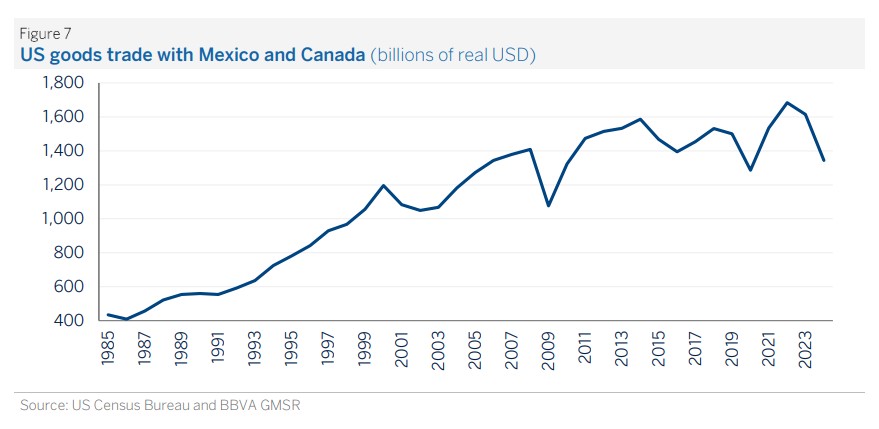
Figure 5: US Goods Trade with Mexico and Canada – This long-term trend chart highlights how trade between the three nations has grown over time. Any disruption from tariffs could impact this trade flow, particularly in sectors like automotive and electronics.
These tariffs could serve two purposes. First, they create leverage in trade negotiations, pushing Mexico to make concessions on trade agreements. Second, they appeal to domestic industries and voters who support protectionist policies. However, while tariffs may temporarily boost US manufacturing, they often lead to retaliatory measures from trading partners, escalating trade disputes.
The Future of US-Mexico Trade Relations
The USMCA plays a crucial role in stabilizing US-Mexico trade. Signed in 2020, the agreement set updated rules on labor, environmental standards, and dispute resolution. However, the 2026 review of USMCA could bring new uncertainties, particularly if US tariffs on Mexico continue to be a major policy tool.
Potential Trade Scenarios:
- Tariff rollback – Lower tariffs could stabilize trade and investment.
- Higher tariffs – Could lead to further trade conflicts and economic downturns.
- USMCA renegotiation – The 2026 review may result in trade rule adjustments.
- Nearshoring slowdown – Companies may reconsider shifting production to Mexico.
If the US imposes new tariffs on Mexican exports, Mexico may respond with its own trade restrictions. This could slow down nearshoring, a trend where companies relocate production to Mexico to be closer to the US market. Many firms moved to Mexico to avoid tariffs on Chinese goods, but additional US tariffs on Mexico could reduce the attractiveness of this strategy.
At the same time, US industries relying on Mexican supply chains may face higher costs. The automotive, electronics, and agricultural sectors would see significant price increases, potentially making US products less competitive in global markets.
Conclusion
US-Mexico tariffs remain a critical factor influencing North America’s economy. In the short term, they create currency fluctuations, disrupt supply chains, and reduce trade volumes. Over the long term, persistent tariffs could lead to economic stagnation, inflation, and shifts in investment flows.
Key Takeaways:
- Short-term: Tariffs cause immediate disruptions, increase costs, and weaken trade relations.
- Long-term: Tariffs could reshape manufacturing, increase inflation, and slow economic growth.
- Political: Tariffs are often used as leverage in trade negotiations and elections.
- Future outlook: The 2026 USMCA review could determine future trade policies.
While tariffs may be used as a political strategy, their economic effects cannot be ignored. For businesses, preparing for potential changes in trade policies is essential. The integration of the US and Mexican economies means that trade disruptions affect both countries significantly, making a cooperative approach to trade policy the most beneficial in the long run.



